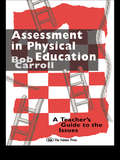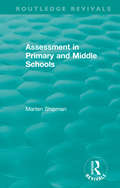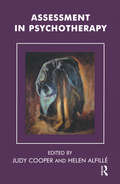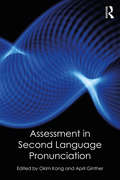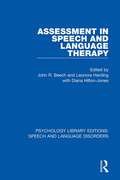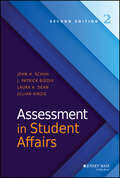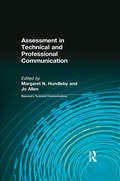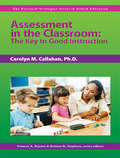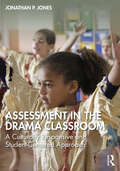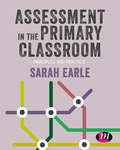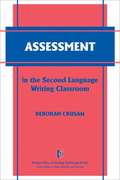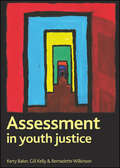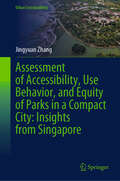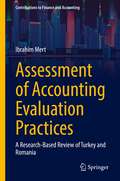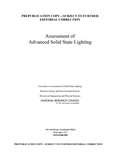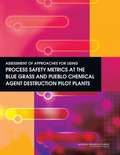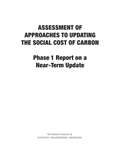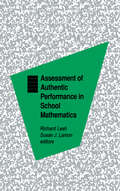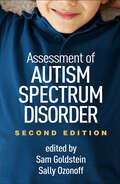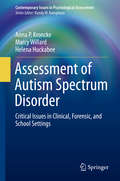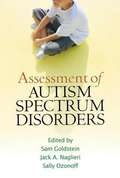- Table View
- List View
Assessment in Physical Education: A Teacher's Guide to the Issues
by Bob CarrollIn the past, assessment was underplayed or neglected in the training of physical education teachers. Physical education lay, largely, outside of school's formal structures of assessment, and books on assessment completely ignored this area of the school curriculum. With the introduction of the GCSE, Routes of Assessment (ROA) and the National Curriculum, assessment has become an important part of the teaching of PE. This book examines in detail the issues as they affect teachers.
Assessment in Practice: Explorations in Identity, Culture, Policy and Inclusion (Current Debates in Educational Psychology)
by Kevin Cahill Kathy Hall Alicia Curtin Dan O'Sullivan Kamil ÖzerkAssessment in Practice explores timely and important questions in relation to assessment. By examining the relationship between identity, culture, policy and inclusion, the book investigates the conflicted and fractured battleground of assessment, and challenges current and practiced understandings of assessment practice. The authors encourage the reader to reconceptualise assessment as a sociocultural practice. Each chapter studies a key theme in the understanding of assessment policy and practice from a sociocultural perspective and provides questions to prompt reflection on the key assessment concepts outlined in the book. Using culture as both a lens and analytic tool, the chapters examine topics such as The social order of assessment, how assessment works in the world and how learning could be assessed Perspectives on social justice and assessment, with a particular focus on social class and other potential inequalities on the experiences of assessment for young people Discussions of ability and the assessment of students with special education needs as well as the role of inclusivity in assessment practice Written by leading academics from University College Cork, the third volume in the successful Routledge Current Debates in Educational Psychology series is an essential read for researchers and postgraduate students in educational research and education psychology.
Assessment in Primary and Middle Schools (Routledge Revivals)
by Marten ShipmanEffective evaluation of a pupil’s performance and of resources available is a vital part of successful teaching. Originally published in 1983, this non-statistical guide aims to help teachers organise their work so as to improve their assessment of their pupils and also to analyse their own management efforts. A model is developed showing how teachers can progressively structure their work to increase the objectivity of their assessment. The use of published tests and the production of tests by teachers is covered, but the focus throughout is on the part played by assessment in the organisation of learning. The steps recommended are arranged so that the first yield the largest return. But none requires any statistical expertise or a large investment of time. The second part of the book shows how schools can be evaluated by their staff – school organisation, staff development and the curriculum are given special attention in this step-by-step guide to effective and rewarding school assessment.
Assessment in Psychotherapy
by Judy Cooper Margret Tonnesmann Helen AlfilléThis book explores the assessment for psychoanalytic psychotherapy from various perspectives. It bridges the two disciplines of medicine and psychotherapy, showing where general practitioners might be able to make an appropriate referral for therapy.
Assessment in Second Language Pronunciation
by April Ginther Okim KangAssessment in Second Language Pronunciation highlights the importance of pronunciation in the assessment of second language speaking proficiency. Leading researchers from around the world cover practical issues as well as theoretical principles, enabling the understanding and application of the theory involved in assessment in pronunciation. Key features of this book include: Examination of key criteria in pronunciation assessment, including intelligibility, comprehensibility and accentedness; Exploration of the impact of World Englishes and English as a Lingua Franca on pronunciation assessment; Evaluation of the validity and reliability of testing, including analysis of scoring methodologies; Discussion of current and future practice in assessing pronunciation via speech recognition technology. Assessment in Second Language Pronunciation is vital reading for students studying modules on pronunciation and language testing and assessment.
Assessment in Speech and Language Therapy (Psychology Library Editions: Speech and Language Disorders)
by John R. Beech Leonora Harding Diana Hilton-JonesWhat assessment tests are available to speech therapists? How are they best used? Originally published in 1993, Assessment in Speech and Language Therapy was designed to guide speech therapists in choosing the most appropriate assessments for evaluation, monitoring and intervention at the time. By providing guidance on defining the issues in assessment, it shows how to make sure that the process will produce a result relevant to the therapist’s own needs and those of his or her clients. The major issues involved are discussed in detail, in particular how to make sure that assessments are relevant to individual needs. This title will be invaluable to all speech therapists and clinical psychologists working in this area.
Assessment in Student Affairs
by Jillian Kinzie John H. Schuh J. Patrick Biddix Laura A. DeanA practical, comprehensive manual for assessment design and implementation Assessment in Student Affairs, Second Edition offers a contemporary look at the foundational elements and practical application of assessment in student affairs. Higher education administration is increasingly called upon to demonstrate organizational effectiveness and engage in continuous improvement based on information generated through systematic inquiry. This book provides a thorough primer on all stages of the assessment process. From planning to reporting and beyond, you'll find valuable assessment strategies to help you produce meaningful information and improve your program. Combining and updating the thoroughness and practicality of Assessment in Student Affairs and Assessment Practice in Student Affairs, this new edition covers design of assessment projects, ethical practice, student learning outcomes, data collection and analysis methods, report writing, and strategies to implement change based on assessment results. Case studies demonstrate real-world application to help you clearly see how these ideas are used effectively every day, and end-of-chapter discussion questions stimulate deeper investigation and further thinking about the ideas discussed. The instructor resources will help you seamlessly integrate this new resource into existing graduate-level courses. Student affairs administrators understand the importance of assessment, but many can benefit from additional direction when it comes to designing and implementing evaluations that produce truly useful information. This book provides field-tested approaches to assessment, giving you a comprehensive how-to manual for demonstrating--and improving--the work you do every day. Build your own assessment to demonstrate organizational effectiveness Utilize quantitative and qualitative techniques and data Identify metrics and methods for measuring student learning Report and implement assessment findings effectively Accountability and effectiveness are the hallmarks of higher education administration today, and they are becoming the metrics by which programs and services are evaluated. Strong assessment skills have never been more important. Assessment in Student Affairs gives you the knowledge base and skill set you need to shine a spotlight on what you and your organization are able to achieve.
Assessment in Technical and Professional Communication (Baywood's Technical Communications)
by AntonioThis collection of essays focuses on both how and why assessment serves as a key element in the teaching and practice of technical and professional communication. The collection is organized to form a dual approach: on the one hand, it offers a landscape view of the activities involved in assessment - examining how it works at institutional, program, and classroom levels; on the other, it surveys the implications of using assessment for formulating, maintaining, and extending the teaching and practice of technical communication. The book offers teachers, students, scholars, and practitioners alike evidence of the increasingly valuable role of assessment in the field, as it supports and enriches our thinking and practice. No other volume has addressed the demands of and the expectations for assessment in technical communication. Consequently, the book has two key goals. The first is to be as inclusive as is feasible for its size, demonstrating the global operation of assessment in the field. For this reason, descriptions of assessment practice lead to examinations of some key feature of the landscape captured by the term 'technical communication'. The second goal is to retain the public and cooperative approach that has characterized technical communication from the beginning. To achieve this, the book represents a 'conversation', with contributors chosen from among practicing, highly active technical communication teachers and scholars; and the chapters set up pairs of opening statement and following response. The overriding purpose of the volume, therefore, is to invite the whole community into the conversation about assessment in technical communication.
Assessment in the Classroom: The Key to Good Instruction
by Carolyn M. CallahanThe goal of all classrooms is to maximize the learning of all students; therefore, correctly assessing what students have learned is an integral part of good instruction. By keeping the goal of good, strong assessment in mind, a teacher can clearly see his or her desired outcomes for a lesson, activity, or unit. It is critical to take into account a student's level of knowledge, understanding, beliefs, skills, dispositions, and learning styles when planning for good classroom instruction and assessment. Carolyn Callahan, a leader in the field of gifted education, guides teachers toward answering these questions about their students and planning for quality classroom assessment. In addition, the book provides an overview of the most common and successful assessment methods, including formal and informal assessments, student self-assessments, and preassessment strategies for planning instruction.
Assessment in the Drama Classroom: A Culturally Responsive and Student-Centered Approach
by Jonathan P. JonesThis textbook offers a practical approach for designing and implementing assessment for learning in the drama classroom. Assessment in the Drama Classroom begins with a theoretical overview that covers the purpose of assessment with student-centered, culturally responsive methods. The following chapters present an in-depth analysis of how to organize drama curriculum, develop measurable learning objectives, and implement a backward planning approach to summative assessment. Models and tools for generating diagnostic, formative, and summative assessments for various grade levels invite the reader to adapt these approaches to their classrooms. Ideal for drama education and pedagogy courses, this book is an accessible tool for drama educators to engage in critical reflection on assessment. Drama educators will find methods and suggestions for reimagining their assessment practices and be empowered to meet the learning needs of their students.
Assessment in the Drama Classroom: A Culturally Responsive and Student-Centered Approach
by Jonathan P. JonesThis textbook offers a practical approach for designing and implementing assessment for learning in the drama classroom.Assessment in the Drama Classroom begins with a theoretical overview that covers the purpose of assessment with student-centered, culturally responsive methods. The following chapters present an in-depth analysis of how to organize drama curriculum, develop measurable learning objectives, and implement a backward planning approach to summative assessment. Models and tools for generating diagnostic, formative, and summative assessments for various grade levels invite the reader to adapt these approaches to their classrooms.Ideal for drama education and pedagogy courses, this book is an accessible tool for drama educators to engage in critical reflection on assessment. Drama educators will find methods and suggestions for reimagining their assessment practices and be empowered to meet the learning needs of their students.
Assessment in the Primary Classroom: Principles and practice (Primary Teaching Now)
by Sarah EarleEssential reading to support principled assessment decisions in the classroom Assessment has become an increasingly complex area for primary schools in recent years, with schools and academy trusts trying to create their own ways of assessing without levels. Trainee teachers find it hard to understand key principles in assessment when practice in each of their school experiences is so varied. This 'essentials' text supports trainee and beginning teachers to understand the current context and consider essential principles for good practice in primary assessment. The book: - features explanations of key terminology - includes practical examples from classrooms and schools - supports teacher assessment literacy - explores the assessment system as a whole - covers formative and summative assessment, pupil progress, data and moderation.
Assessment in the Primary Classroom: Principles and practice (Primary Teaching Now)
by Sarah EarleEssential reading to support principled assessment decisions in the classroom Assessment has become an increasingly complex area for primary schools in recent years, with schools and academy trusts trying to create their own ways of assessing without levels. Trainee teachers find it hard to understand key principles in assessment when practice in each of their school experiences is so varied. This 'essentials' text supports trainee and beginning teachers to understand the current context and consider essential principles for good practice in primary assessment. The book: - features explanations of key terminology - includes practical examples from classrooms and schools - supports teacher assessment literacy - explores the assessment system as a whole - covers formative and summative assessment, pupil progress, data and moderation.
Assessment in the Second Language Writing Classroom
by Deborah CrusanAssessment in the Second Language Writing Classroom is a teacher and prospective teacher-friendly book, uncomplicated by the language of statistics. The book is for those who teach and assess second language writing in several different contexts: the IEP, the developmental writing classroom, and the sheltered composition classroom. In addition, teachers who experience a mixed population or teach cross-cultural composition will find the book a valuable resource. Other books have thoroughly covered the theoretical aspects of writing assessment, but none have focused as heavily as this book does on pragmatic classroom aspects of writing assessment. Further, no book to date has included an in-depth examination of the machine scoring of writing and its effects on second language writers. Crusan not only makes a compelling case for becoming knowledgeable about L2 writing assessment but offers the means to do so. Her highly accessible, thought-provoking presentation of the conceptual and practical dimensions of writing assessment, both for the classroom and on a larger scale, promises to engage readers who have previously found the technical detail of other works on assessment off-putting, as well as those who have had no previous exposure to the study of assessment at all.
Assessment in youth justice
by Kerry Baker Gill KellyThis book provides a comprehensive introduction to the theory and practice of assessment and intervention planning with young people who offend. It will help equip practitioners with the knowledge and professional skills central to these critically important tasks. The context for practice is changing rapidly and the authors take into account current policy developments along with a wide range of literature on assessment practice in criminal justice and social care. The book encourages readers to think critically and to take practical steps to enhance their own practice. It will be important reading for anyone working with young people who offend.
Assessment of Accessibility, Use Behavior, and Equity of Parks in a Compact City: Insights from Singapore (Urban Sustainability)
by Jingyuan ZhangThis book presents methodological and empirical advancements in evaluating the accessibility, use demand and behavior, and equity of urban parks. A comparative analysis was conducted across four planning areas in Singapore, a renowned compact city. An innovated conceptual framework was devised to effectively measure residents’ physical and perceived accessibility to their most often visited parks, explore their perceptional park use demand and behavior, as well as to evaluate the spatial equity of park distribution. This was achieved through spatial analysis combined with a household perception study involving 597 participants. The target audience for this book includes undergraduate and graduate students interested in accessibility, behavior and equity analysis, researchers focusing on spatial and behavioral analysis of urban public facilities, and practitioners involved in the planning and management of urban parks and greenspaces.
Assessment of Accounting Evaluation Practices: A Research-Based Review of Turkey and Romania (Contributions to Finance and Accounting)
by Ibrahim MertThe book describes the historical evolution and development of accounting theories and principles. Value and valuation have been reviewed extensively. The author provides a detailed comparison between historic and fair value accounting. A comprehensive review of the literature and researchers’ opinions about measurement, fair value, and historical cost value will enable the readers to understand the concepts in detail. Additionally, the book includes case studies evaluating the accounting practices in Turkey and Romania to illustrate how these concepts are implemented in practice. The reader will obtain a good understanding of the local nationalized accounting systems, and up to what extent countries have adapted to IFRS. The books discusses the usage of IT tools in accounting and analyses the impact of information technology such as big data, artificial intelligence, and data analytics in the field of accounting.
Assessment of Advanced Solid-State Lighting
by Board On Energy Environmental Systems Committee on Assessment of Solid-State LightingThe standard incandescent light bulb, which still works mainly as Thomas Edison invented it, converts more than 90% of the consumed electricity into heat. Given the availability of newer lighting technologies that convert a greater percentage of electricity into useful light, there is potential to decrease the amount of energy used for lighting in both commercial and residential applications. Although technologies such as compact fluorescent lamps (CFLs) have emerged in the past few decades and will help achieve the goal of increased energy efficiency, solid-state lighting (SSL) stands to play a large role in dramatically decreasing U.S. energy consumption for lighting. This report summarizes the current status of SSL technologies and products-light-emitting diodes (LEDs) and organic LEDs (OLEDs)-and evaluates barriers to their improved cost and performance. Assessment of Advanced Solid State Lighting also discusses factors involved in achieving widespread deployment and consumer acceptance of SSL products. These factors include the perceived quality of light emitted by SSL devices, ease of use and the useful lifetime of these devices, issues of initial high cost, and possible benefits of reduced energy consumption.
Assessment of Agent Monitoring Strategies for the Blue Grass and Pueblo Chemical Agent Destruction Pilot Plants
by Committee on Assessment of Agent Monitoring Strategies for the Blue Grass Pueblo Chemical Agent Destruction Pilot PlantsJanuary 2012 saw the completion of the U. S. Army's Chemical Materials Agency's (CMA's) task to destroy 90 percent of the nation's stockpile of chemical weapons. CMA completed destruction of the chemical agents and associated weapons deployed overseas, which were transported to Johnston Atoll, southwest of Hawaii, and demilitarized there. The remaining 10 percent of the nation's chemical weapons stockpile is stored at two continental U. S. depots, in Lexington, Kentucky, and Pueblo, Colorado. Their destruction has been assigned to a separate U. S. Army organization, the Assembled Chemical Weapons Alternatives (ACWA) Element. ACWA is currently constructing the last two chemical weapons disposal facilities, the Pueblo and Blue Grass Chemical Agent Destruction Pilot Plants (denoted PCAPP and BGCAPP), with weapons destruction activities scheduled to start in 2015 and 2020, respectively. ACWA is charged with destroying the mustard agent stockpile at Pueblo and the nerve and mustard agent stockpile at Blue Grass without using the multiple incinerators and furnaces used at the five CMA demilitarization plants that dealt with assembled chemical weapons - munitions containing both chemical agents and explosive/propulsive components. The two ACWA demilitarization facilities are congressionally mandated to employ noncombustion-based chemical neutralization processes to destroy chemical agents. In order to safely operate its disposal plants, CMA developed methods and procedures to monitor chemical agent contamination of both secondary waste materials and plant structural components. ACWA currently plans to adopt these methods and procedures for use at these facilities. The Assessment of Agent Monitoring Strategies for the Blue Grass and Pueblo Chemical Agent Destruction Pilot Plants report also develops and describes a half-dozen scenarios involving prospective ACWA secondary waste characterization, process equipment maintenance and changeover activities, and closure agent decontamination challenges, where direct, real-time agent contamination measurements on surfaces or in porous bulk materials might allow more efficient and possibly safer operations if suitable analytical technology is available and affordable.
Assessment of Approaches for Using Process Safety Metrics at the Blue Grass and Pueblo Chemical Agent Destruction Pilot Plants
by National Research Council of the National AcademiesThe Department of Defense, through the Assembled Chemical Weapons Alternatives program, is currently in the process of constructing two full-scale pilot plants at the Pueblo Chemical Depot in Colorado and the Blue Grass Army Depot in Kentucky to destroy the last two remaining inventories of chemical weapons in the U.S. stockpile. Unlike their predecessors, these facilities will use neutralization technologies to destroy agents contained within rockets, projectiles, and mortar rounds, requiring the use of specially designed equipment. Concern about potential problems associated with using this "first-of-a-kind" equipment, and the need to ensure that plant operations adhere to congressional mandates calling for the maximum protection of workers, the public, and the environment, led the Program Manager for Assembled Chemical Weapons Alternatives to request that the National Research Council undertake a study to guide the development and application of process safety metrics for the Pueblo and Blue Grass facilities.
Assessment of Approaches to Updating the Social Cost of Carbon: Phase 1 Report on a Near-Term Update
by Engineering Medicine National Academies of SciencesThe social cost of carbon (SCC) for a given year is an estimate, in dollars, of the present discounted value of the damage caused by a 1-metric ton increase in CO2 emissions into the atmosphere in that year; or equivalently, the benefits of reducing CO2 emissions by the same amount in that given year. The SCC is intended to provide a comprehensive measure of the monetized value of the net damages from global climate change from an additional unit of CO2, including, but not limited to, changes in net agricultural productivity, energy use, human health effects, and property damages from increased flood risk. Federal agencies use the SCC to value the CO2 emissions impacts of various policies including emission and fuel economy standards for vehicles, regulations of industrial air pollutants from industrial manufacturing, emission standards for power plants and solid waste incineration, and appliance energy efficiency standards. There are significant challenges to estimating a dollar value that reflects all the physical, human, ecological, and economic impacts of climate change. Recognizing that the models and scientific data underlying the SCC estimates evolve and improve over time, the federal government made a commitment to provide regular updates to the estimates. To assist with future revisions of the SCC, the Interagency Working Group on the Social Cost of Carbon (IWG) requested the National Academies of Sciences, Engineering, and Medicine complete a study that assessed the merits and challenges of a limited near-term update to the SCC and of a comprehensive update of the SCC to ensure that the estimates reflect the best available science. This interim report focuses on near-term updates to the SCC estimates.
Assessment of Authentic Performance in School Mathematics
by Richard Lesh Susan J. LamonThis book is the result of a conference sponsored by the Educational Testing Service and the University of Wisconsin's National Center for Research in Mathematical Sciences Education. The purpose of the conference was to facilitate the work of a group of scholars whose interests included the assessment of higher-order understandings and processes in foundation-level (pre-high school) mathematics. Discussions focused on such issues as the purposes of assessment, guidelines for producing and scoring "real-life" assessment activities, and the meanings of such terms as "deeper and higher-order understanding," "cognitive objectives," and "authentic mathematical activities." Assessment was viewed as a critical component of complex, dynamic, and continually adapting educational systems. During the time that the chapters in this book were being written, sweeping changes in mathematics education were being initiated in response to powerful recent advances in technology, cognitive psychology, and mathematics, as well as to numerous public demands for educational reform. These changes have already resulted in significant reappraisals of what it means to understand mathematics, of the nature of mathematics teaching and learning, and of the real-life situations in which mathematics is useful. The challenge was to pursue assessment-related initiatives that are systematically valid, in the sense that they work to complement and enhance other improvements in the educational system rather than act as an impediment to badly needed curriculum reforms. To address these issues, most chapters in this book focus on clarifying and articulating the goals of assessment and instruction, and they stress the content of assessment above its mode of delivery. Computer- or portfolio-based assessments are interpreted as means to ends, not as ends in themselves. Assessment is conceived as an ongoing documentation process, seamless with instruction, whose quality hinges upon its ability to provide complete and appropriate information as needed to inform priorities in instructional decision making. This book tackles some of the most complicated issues related to assessment, and it offers fresh perspectives from leaders in the field--with the hope that the ultimate consumer in the instruction/assessment enterprise, the individual student, will reclaim his or her potential for self-directed mathematics learning.
Assessment of Autism Spectrum Disorder, Second Edition
by Sally Ozonoff Sam GoldsteinThis authoritative resource, now thoroughly revised for DSM-5, has set the standard for the comprehensive assessment of autism spectrum disorder (ASD). Leading experts demonstrate how to craft a scientifically grounded profile of each child’s strengths and difficulties, make a formal diagnosis, and use assessment data to guide individualized intervention in clinical and school settings. Chapters review state-of-the-art instruments and approaches for evaluating specific areas of impairment in ASD and co-occurring emotional and behavioral disorders. Considerations in working with children of different ages are highlighted. With a primary focus on children, several chapters also address assessment of adolescents and adults. New to This Edition *Chapter on key implications of DSM-5 diagnostic criteria, plus related updates throughout the volume. *Chapter on advances in early identification (ages 0–3). *Chapter with in-depth case examples illustrating the evaluation decision-making process and common diagnostic challenges. *Chapters on pseudoscience (including strategies for advising parents) and future directions in the field. *Current assessment data, numerous new and revised measures, and cutting-edge screening approaches.
Assessment of Autism Spectrum Disorder: Critical Issues in Clinical, Forensic and School Settings (Contemporary Issues in Psychological Assessment)
by Anna P. Kroncke Marcy Willard Helena HuckabeeThis book offers clear best-practice guidelines for the assessment of Autism Spectrum Disorder. It discusses both the rising rates of autism and the growing need for appropriate, effective treatments and services. The book examines measures and methods used in assessing for core symptoms of ASD as well as memory, attention, visual and spatial skills, and other areas relevant to autism assessment. In-depth material on differential diagnosis and a range of comorbid conditions depict the complexities of the assessment process and the necessity of accurate identification. The book's case vignettes and sample recommendations add practical and personal dimensions to issues and challenges surrounding diagnosis. Topics featured include: A practical guide to the comprehensive assessment process. Discussion of the assessment process from referral to recommendation. Diagnostic framework for ASD and other disorders School-based ASD eligibility evaluation. Assessment across the lifespan. Assessment of Autism Spectrum Disorder is an important tool for clinicians, practitioners, researchers and graduate students in the fields of child and school psychology, behavioral therapy, and social work as well as the related areas of psychiatry, pediatrics, forensic psychology, and educational and healthcare policy.
Assessment of Autism Spectrum Disorders
by Sam Goldstein Jack NaglieriSignificant progress has been made in assessing children with autism spectrum disorders, but the field has lacked a single, comprehensive resource that assembles current best practices within a unified assessment framework. This authoritative book demonstrates how to craft a complete, scientifically grounded, and clinically useful portrait of a child's strengths and difficulties in social behavior, language and communication, intellectual functioning, motor skills, and other key areas of impairment and comorbidity. Leading experts illustrate ways in which school and clinical practitioners can integrate data from a variety of sources to improve the accuracy of diagnosis and inform the development of individualized interventions.
